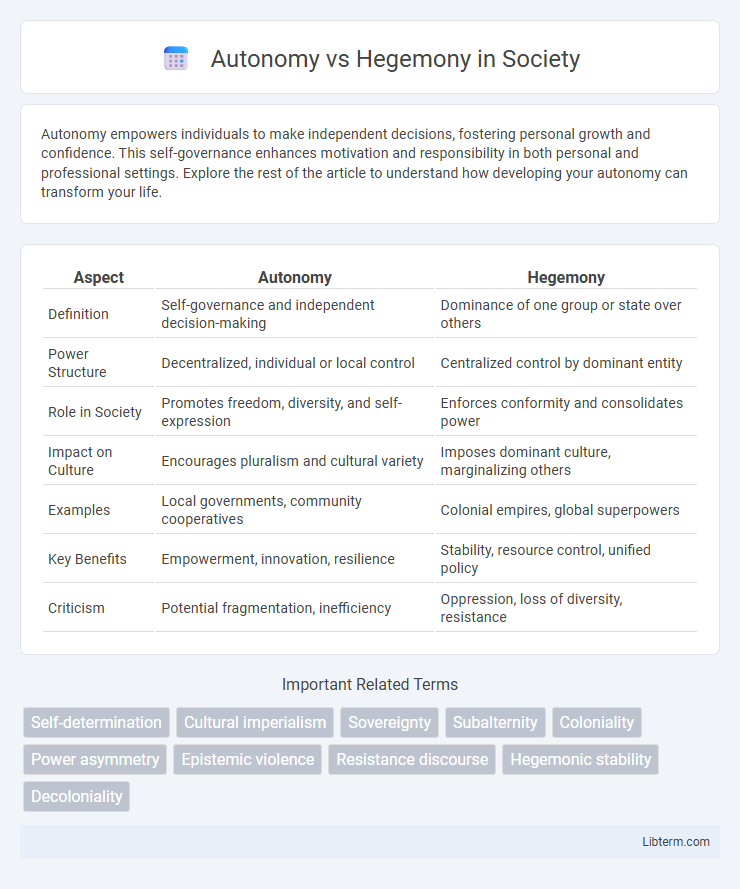Autonomy empowers individuals to make independent decisions, fostering personal growth and confidence. This self-governance enhances motivation and responsibility in both personal and professional settings. Explore the rest of the article to understand how developing your autonomy can transform your life.
Table of Comparison
| Aspect | Autonomy | Hegemony |
|---|---|---|
| Definition | Self-governance and independent decision-making | Dominance of one group or state over others |
| Power Structure | Decentralized, individual or local control | Centralized control by dominant entity |
| Role in Society | Promotes freedom, diversity, and self-expression | Enforces conformity and consolidates power |
| Impact on Culture | Encourages pluralism and cultural variety | Imposes dominant culture, marginalizing others |
| Examples | Local governments, community cooperatives | Colonial empires, global superpowers |
| Key Benefits | Empowerment, innovation, resilience | Stability, resource control, unified policy |
| Criticism | Potential fragmentation, inefficiency | Oppression, loss of diversity, resistance |
Understanding Autonomy and Hegemony: Key Definitions
Autonomy refers to the capacity of an individual or group to make independent decisions and govern without external control, emphasizing self-determination and freedom. Hegemony involves dominance by one entity over others, often manifesting as political, cultural, or economic influence that shapes behaviors and ideologies. Understanding these key definitions helps clarify the dynamics between self-governance and power structures in social and political contexts.
Historical Roots of Autonomy and Hegemony
The historical roots of autonomy trace back to ancient city-states like Athens and Sparta, where self-governance and independent decision-making laid the foundational principles of political sovereignty. Hegemony emerged distinctly in the context of empires such as Rome and the British Empire, characterized by overarching control and influence over subordinate states through military, economic, and cultural dominance. These contrasting origins highlight autonomy's emphasis on local self-rule versus hegemony's strategic enforcement of power across diverse territories.
The Dynamics of Power: How Hegemony Shapes Autonomy
Hegemony exerts control by defining norms and influencing decision-making processes, thereby constraining the scope of autonomy available to subordinate entities. Power dynamics under hegemony establish frameworks within which autonomous actions must operate, often limiting independent policy development or self-governance. The interplay between dominant hegemonic forces and marginalized autonomy reveals how power structures shape opportunities for self-determination and limit resistance within political, social, and economic contexts.
Autonomy in Political Systems: Case Studies
Autonomy in political systems emphasizes self-governance, allowing regions or groups to exercise independent decision-making while maintaining overall national unity. Case studies such as Scotland's devolved parliament and Catalonia's regional government demonstrate how autonomy can address local needs and cultural identity within larger sovereign states. These examples highlight the balance between regional self-rule and centralized authority, contributing to political stability and conflict reduction.
Economic Dimensions: Hegemony’s Impact on Independent Growth
Economic hegemony exerts significant control over global markets, often limiting the ability of autonomous nations to achieve independent growth by imposing trade dependencies and financial regulations favoring dominant states. This power imbalance restricts access to investment and technology for less influential economies, hindering their development and reinforcing cycles of economic reliance. Consequently, hegemonic economic policies prioritize the interests of leading powers, reducing the scope for sovereign decision-making and sustainable growth in subordinate regions.
Cultural Narratives: Autonomy vs Hegemony in Identity Formation
Cultural narratives of autonomy versus hegemony profoundly influence identity formation by shaping how individuals and communities perceive agency and power within societal structures. Autonomy narratives emphasize self-determination and resistance against dominant hegemonic discourses that seek to impose uniform identities. The tension between these forces drives the construction of hybrid identities that negotiate between preserving cultural uniqueness and responding to hegemonic pressures in political, social, and cultural contexts.
International Relations: Balancing Sovereignty and Influence
Autonomy in international relations emphasizes state sovereignty, allowing nations to make decisions free from external control, which strengthens national identity and self-determination. Hegemony involves dominant states exerting influence or control over others, shaping global norms and policies to align with their strategic interests. Balancing autonomy and hegemony requires navigating power dynamics to preserve national independence while engaging in cooperative frameworks that address transnational challenges.
Resistance to Hegemony: Movements for Autonomy
Movements for autonomy emerge as powerful resistances against hegemonic control, emphasizing self-determination, cultural preservation, and political independence. Indigenous groups, regional minorities, and oppressed nations often mobilize through grassroots activism, legal battles, and international advocacy to reclaim authority over their lands and identities. These struggles highlight the tension between centralized power and local sovereignty, fueling demands for decentralization and equitable governance structures globally.
The Role of Technology: Enabling or Undermining Autonomy
Technological advancements shape the balance between autonomy and hegemony by either empowering individuals and communities or reinforcing centralized control. Innovations such as decentralized networks and encryption support autonomy by enabling privacy, self-governance, and resilient communication. Conversely, surveillance systems, data monopolies, and algorithmic governance consolidate hegemonic power by limiting transparency and individual agency.
Future Prospects: Navigating Autonomy vs Hegemony in a Globalized World
Future prospects for navigating autonomy versus hegemony in a globalized world involve balancing national sovereignty with the influence of dominant powers and international institutions. Emerging technological advancements and evolving geopolitical alliances will play crucial roles in reshaping power dynamics and enabling smaller states to assert greater autonomy. Strategic diplomacy and multilateral cooperation are essential for managing tensions between self-determination and external dominance in an interconnected global landscape.
Autonomy Infographic

 libterm.com
libterm.com